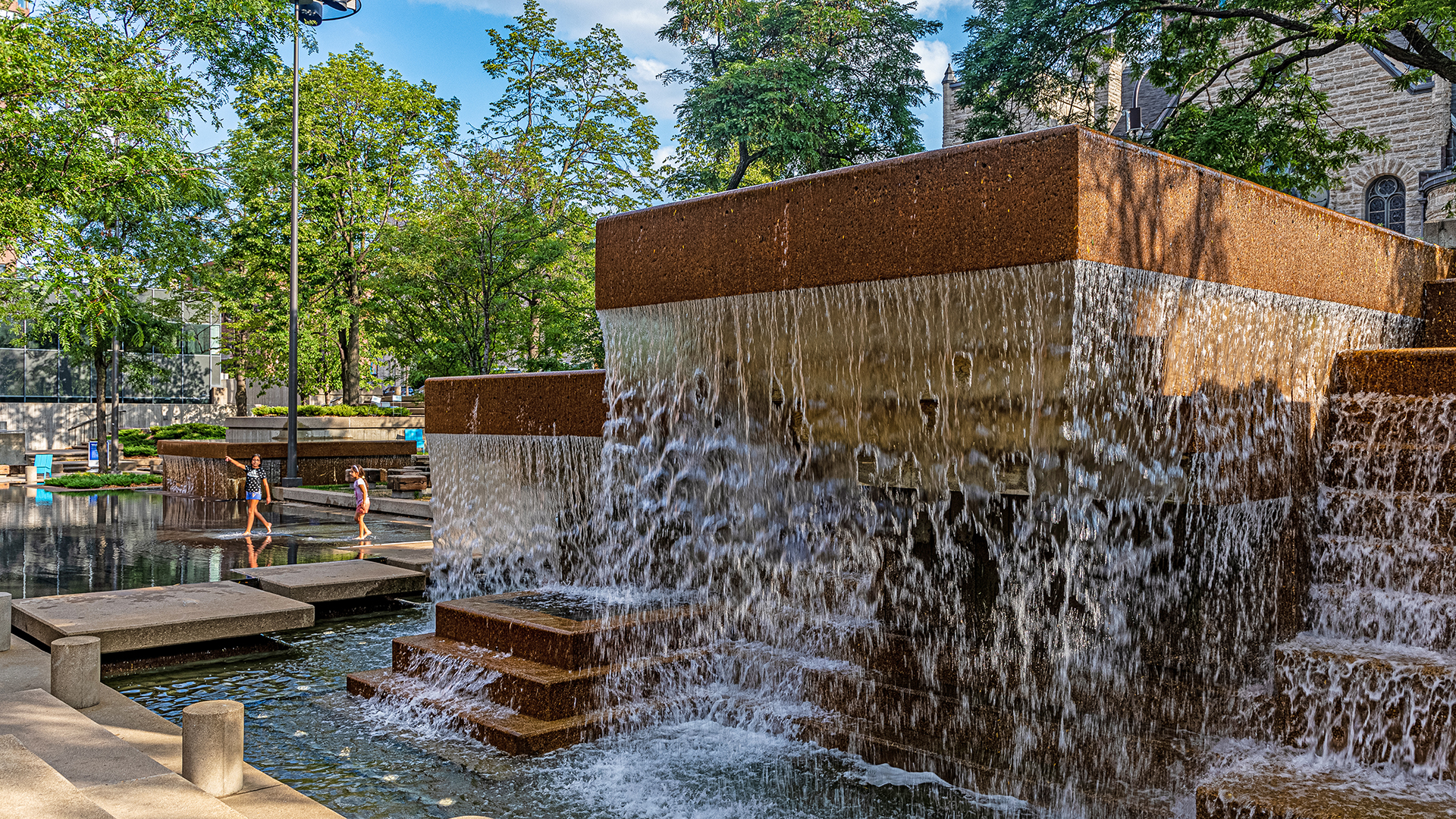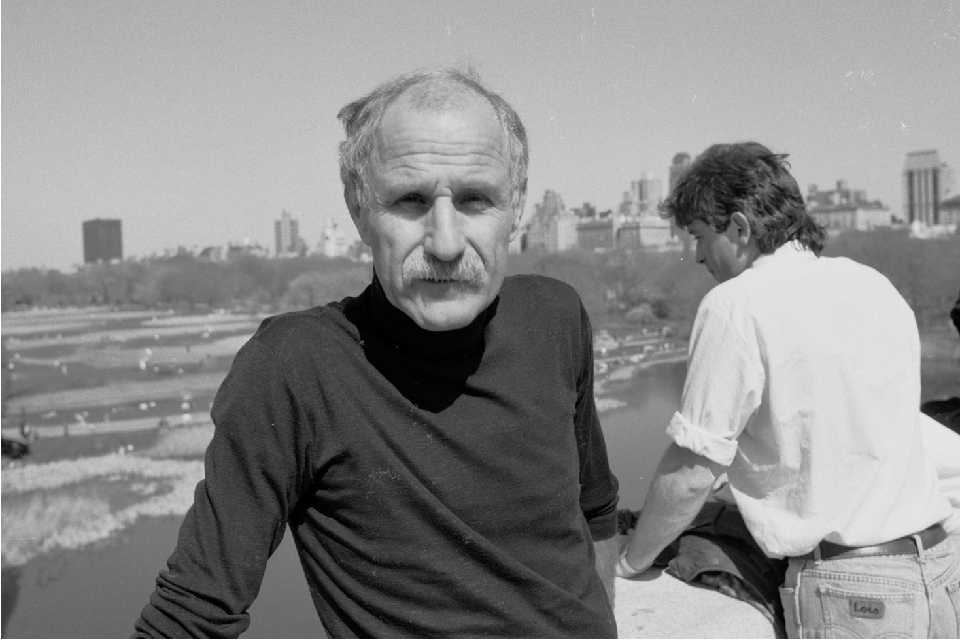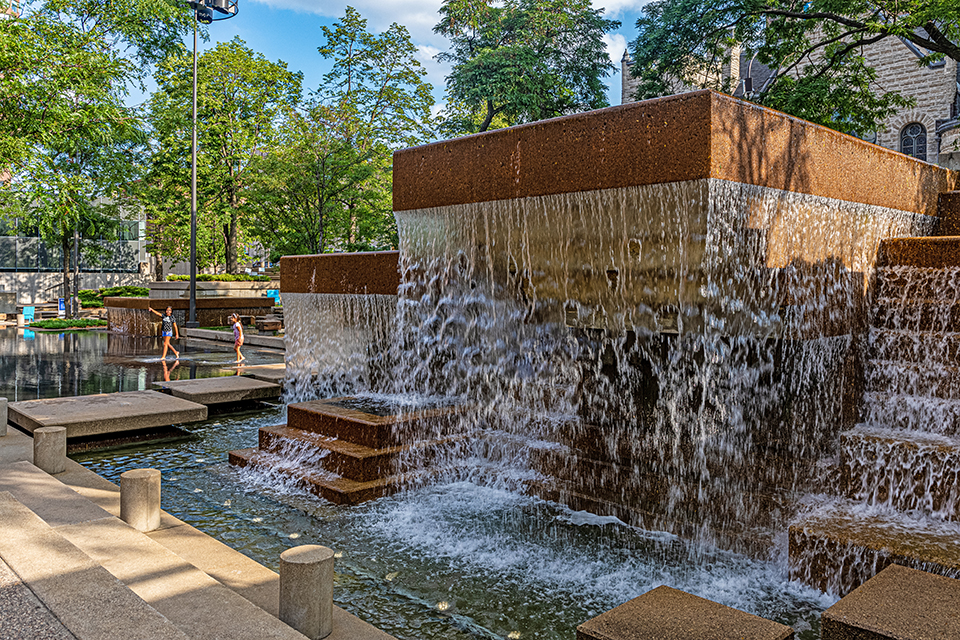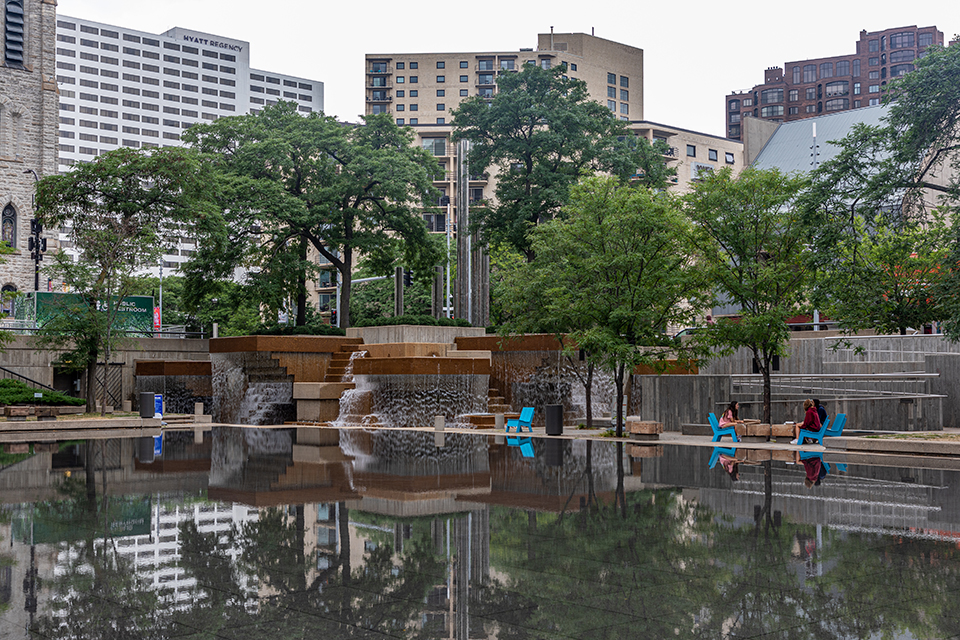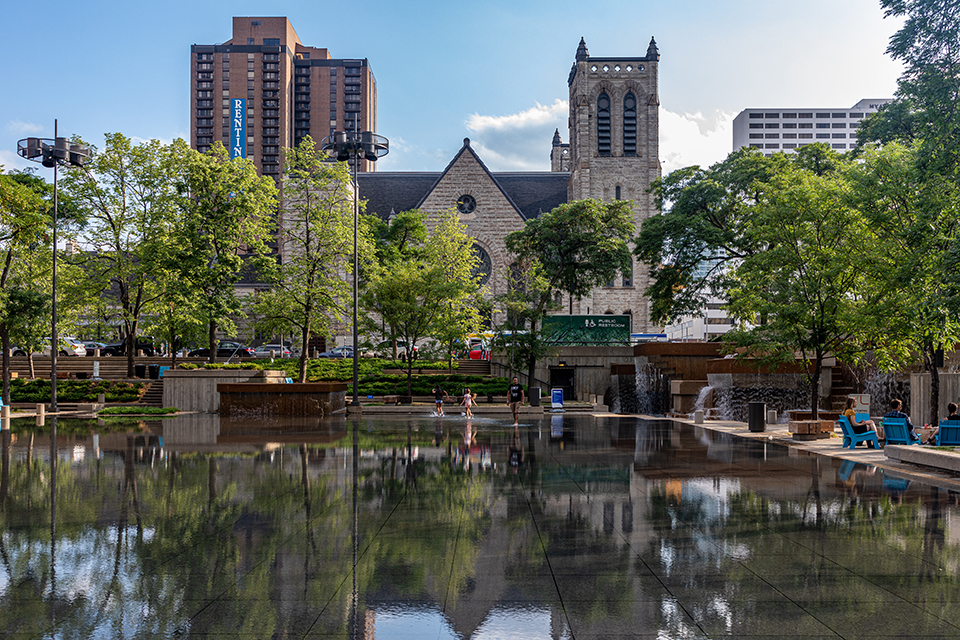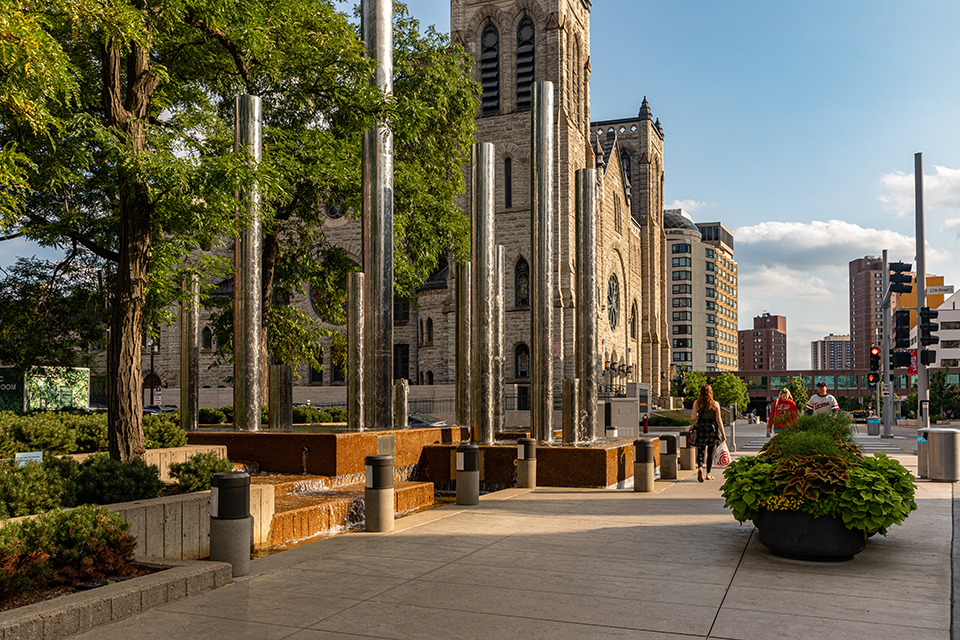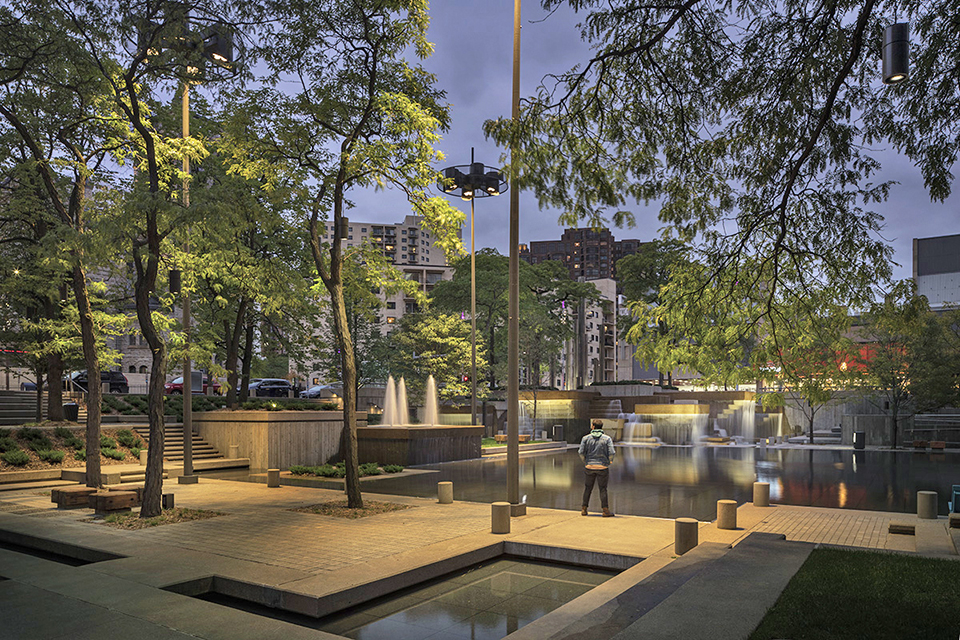In the 21st century, three of what are considered M. Paul Friedberg’s most important extant commissions came under threat. Riis Park Plaza in New York City, a pioneering and career-making work from 1965, was demolished in 2000. In 2015 Pershing Park in Washington, D.C., which opened in 1981, was to become a national World War I Memorial; after several years of advocacy, demolition was prevented, but a rehabilitation of the site fundamentally altered its core. Peavey Plaza in Minneapolis was also slated for demolition. However, years of unrelenting advocacy and litigation upended attempts to raze the site and instead resulted in its successful and sympathetic rehabilitation.
Background
Peavey Plaza was a product of the upheaval in urban America after World War II, when many cities were in crisis. Businesses and residents that were able to move to the suburbs did. Those left behind saw their communities drained of economic vitality, bisected by freeways, and torn by social strife. Minneapolis began witnessing the same pattern; however, instead of joining the exodus, a group of powerful business leaders and far-sighted government officials led a counterattack, funneling investment back into the city.
In 1967 landscape architect Lawrence Halprin designed a conversion of Nicollet Avenue into the pedestrian-friendly Nicollet Mall. The mall was, paradoxically, almost too successful. Organized festivities drew crowds as hoped, but the clogged sidewalks made it hard for shoppers to get to stores. Plans were soon underway to extend the mall four blocks south, adding a plaza along the way as a gathering place for programmed events and as an informal refuge from the dense city grid. A greenway would connect the mall to Loring Park, the original Central Park of the city’s renowned park system.
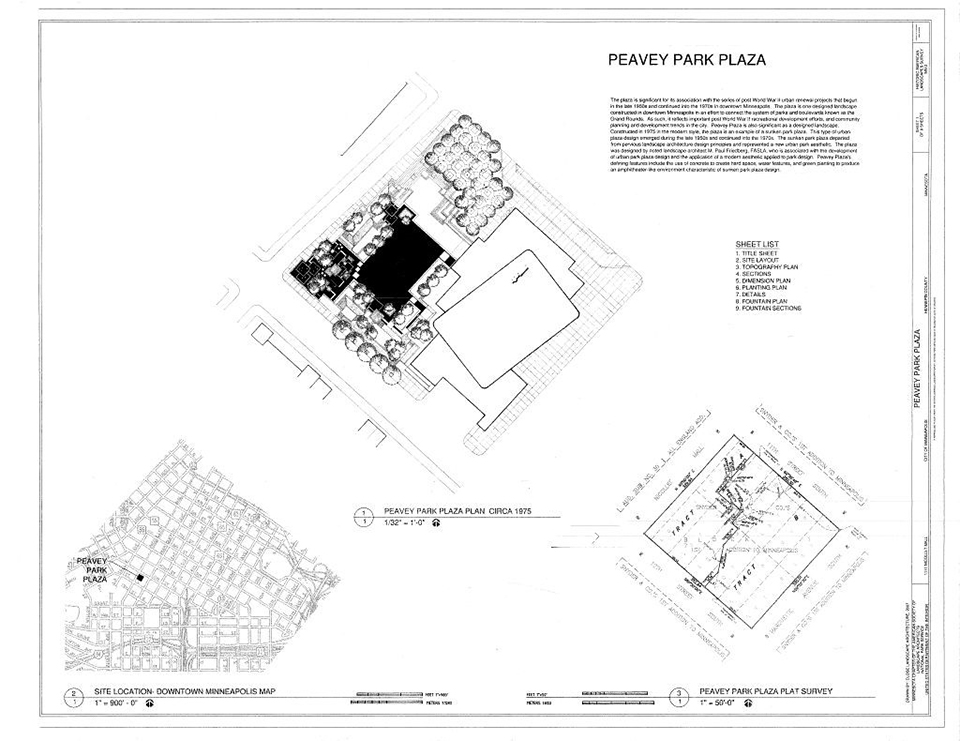 Peavey Plaza Plan circa 1975, Peavey Plaza, Minneapolis, 2000. Image Courtesy HABS.
Peavey Plaza Plan circa 1975, Peavey Plaza, Minneapolis, 2000. Image Courtesy HABS.
M. Paul Friedberg + Partners created Peavey Plaza in 1975. Often referred to by Friedberg as a “park-plaza,” this two-acre space is also described by him as “a mixture of the American green space and the European hard space.” The plaza contains many design elements that would appear in his later design for Pershing Park. These include amphitheater-style seating oriented around the sunken plaza which also served as a pool basin (filled with water during the summer or frozen in winter for skating), cascading and spraying fountains to animate the space, lawn terraces, and many sculptural objects. The plaza affords ample opportunities for large- and small-scale gatherings. In its coverage of the plaza’s opening celebration in June 1975, the Minneapolis Star-Tribune editorialized: “Peavey Plaza … is a graceful and pleasant place for relaxation, entertainment and community events. … The plaza sets a high standard” for developments in the Loring Park Development District.
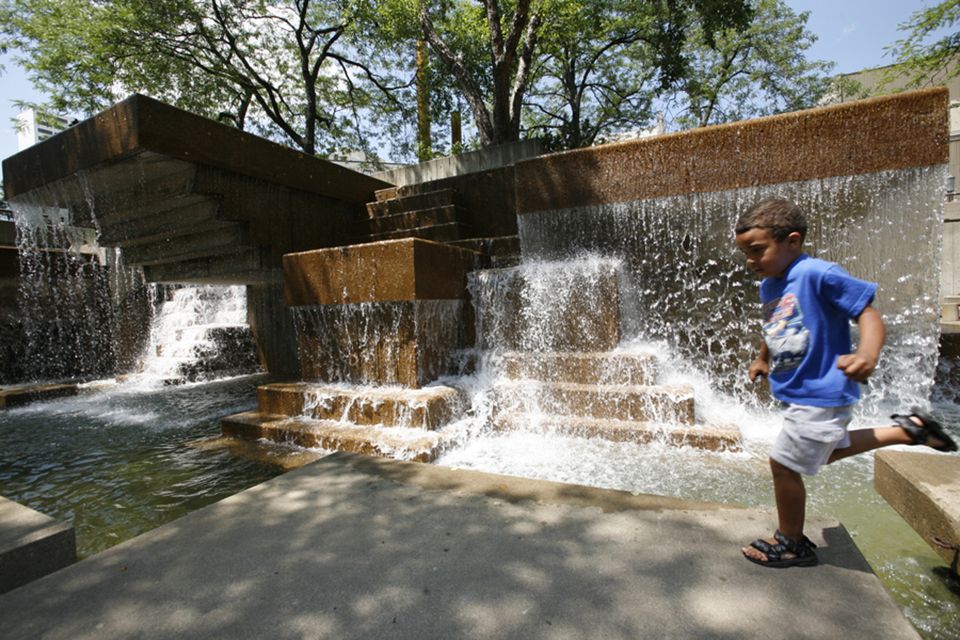 Peavey Plaza, Minneapolis, MN, 2008. Photo by Keri Pickett, courtesy The Cultural Landscape Foundation.
Peavey Plaza, Minneapolis, MN, 2008. Photo by Keri Pickett, courtesy The Cultural Landscape Foundation.
The site, adjacent to Minneapolis Orchestra Hall, was recognized by the American Society of Landscape Architects (ASLA) with an ASLA Centennial Medallion on the society’s 100th anniversary in 1999.
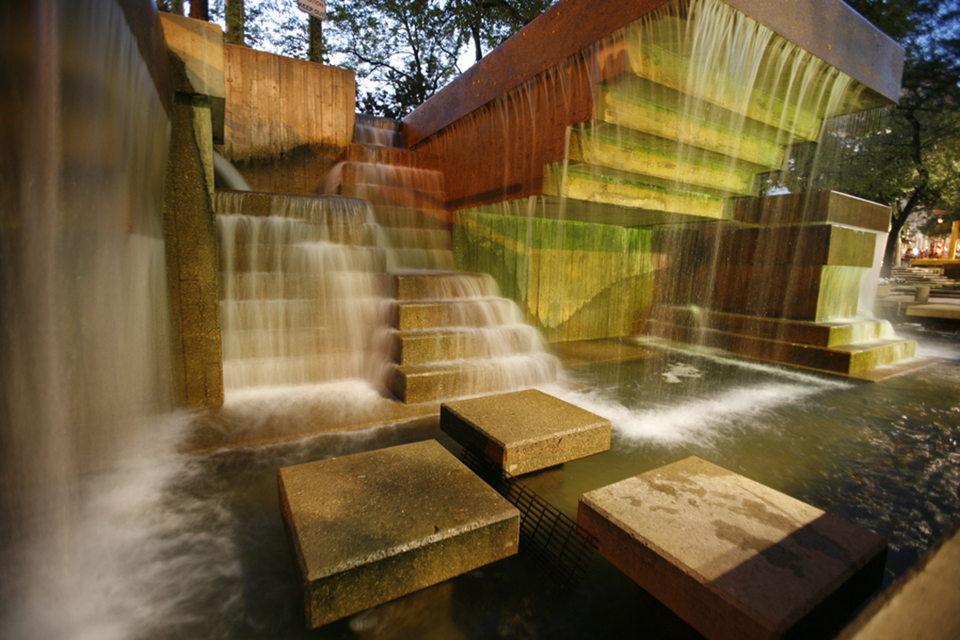
Peavey Plaza, Minneapolis, MN, 2008. Photo by Keri Pickett, courtesy The Cultural Landscape Foundation.
Advocacy and Engagement
In 2008, prompted by a proposed expansion of neighboring Orchestra Hall along with the plaza’s inadequate maintenance and the resulting deterioration, the site was included in TCLF’s Landslide report and exhibition Marvels of Modernism; the Preservation Alliance of Minnesota (PAM, now Rethos), a statewide nonprofit group, named Peavey to its “Most Endangered” list.
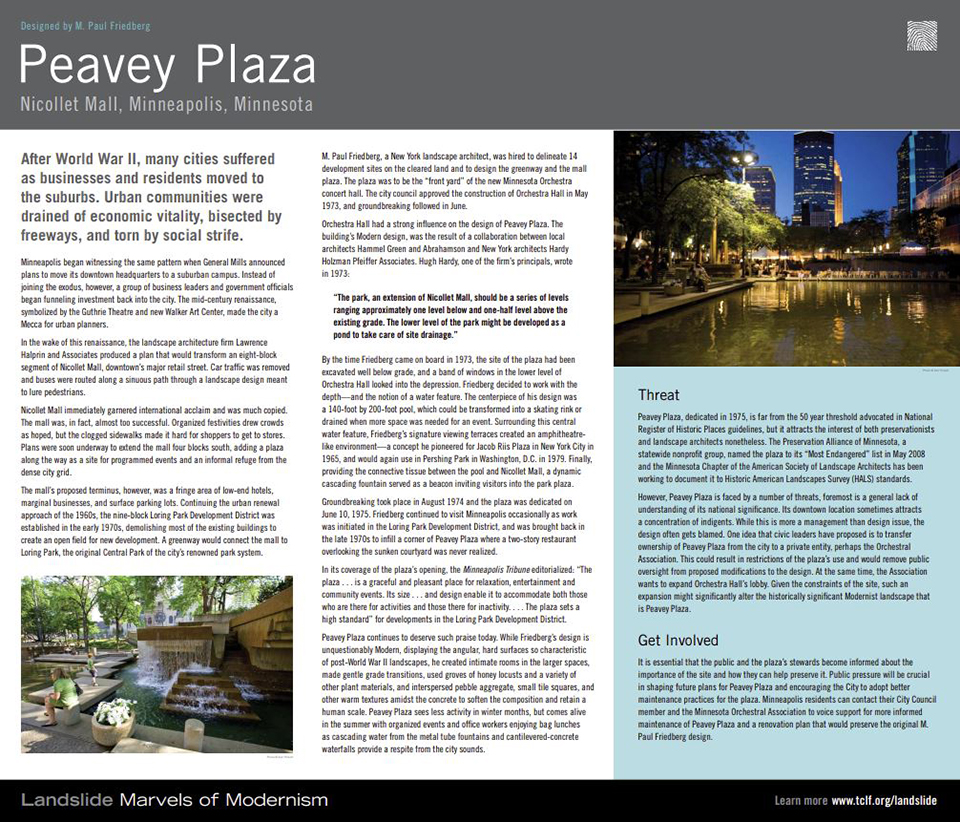 Peavey Plaza Signboard, Marvels of Modernism, 2008. Image courtesy The Cultural Landscape Foundation.
Peavey Plaza Signboard, Marvels of Modernism, 2008. Image courtesy The Cultural Landscape Foundation.
In 2009 Peavey Plaza was featured in the book, Shaping the American Landscape: New Profiles from the Pioneers of American Landscape Design Project, which chronicles more than 250 years of American landscape design.
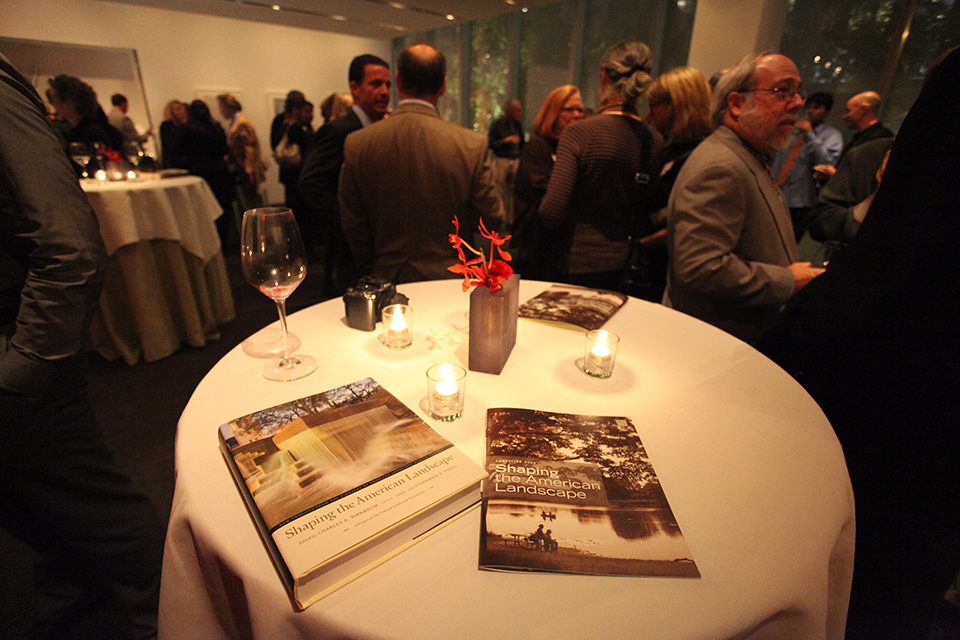 Shaping the American Landscape (left) features Peavey Plaza on its cover, Launch Party at MoMa, New York, N.Y., 2009. Photo courtesy The Cultural Landscape Foundation.
Shaping the American Landscape (left) features Peavey Plaza on its cover, Launch Party at MoMa, New York, N.Y., 2009. Photo courtesy The Cultural Landscape Foundation.
There were positive developments in 2010; in a November public meeting chaired by Minneapolis Mayor R.T. Rybak, Minneapolis-based Oslund and Associates (now O2 Design), was selected to revitalize the plaza. The design team included the original landscape architect, M. Paul Friedberg, and TCLF’s President & CEO, Charles A. Birnbaum. However, by mid-2011, Friedberg and Birnbaum were released from their responsibilities. A review process choreographed by the city and the Minneapolis Orchestra, which was undergoing a $45 million renovation, resulted in a decision not to restore/rehabilitate the plaza, but rather to demolish. The orchestra didn’t want the plaza and city officials claimed that the site was in poor condition, did not meet ADA, and that the restoration would cost too much money. However, the demolition permit filed revealed the city’s direct role in creating the problem: "An intentional effort has been made in recent years to hold the line on maintenance costs, including the decision not to repair some fountains and other infrastructure and to reduce the staff time at the plaza." In other words, the city deliberately withheld maintenance and then blamed the park for deteriorating.
Demolition required the approval of the city’s Historic Preservation Commission (HPC). On April 17, 2012, a coalition of local and national organizations including TCLF, Preserve Minneapolis, Preservation Alliance of Minnesota, the regional office of the National Trust for Historic Preservation, and the Minnesota chapter of Docomomo U.S., submitted a detailed letter calling for the commission to oppose demolition, which the commission did in an eight-to-one vote. However, the next month the City Council overturned the HPC decision and reaffirmed demolition.
On June 28, 2012, TCLF and PAM filed suit against the City of Minneapolis to protect Peavey Plaza from demolition, arguing that the city’s proposed demolition intent violated the Minnesota Environmental Rights Act (MERA), which protects natural resources from pollution, impairment, or destruction. Under Section 116B.02, Subd. 4, this protection extends to historic resources like Peavey Plaza. MERA gives citizens, and groups like TCLF and PAM, the right to ask a court to enjoin the city from demolishing historic resources and to force the city to consider reasonable alternatives to demolition.
Concurrently, a nomination for listing Peavey Plaza in the National Register of Historic Places, prepared by Minneapolis-based Hess, Roise and Company, was advancing. On November 5, 2012, the HPC supported the nomination followed a week later by the Minnesota State Review Board. In January 2013 Peavey was listed in the National Register; it was the first work by Friedberg listed and recognized as an “exceptionally important” site, a requirement for properties younger than 50 years.
On October 1, 2013, the City Council reversed course and voted to approve a settlement ending the lawsuit filed by TCLF and PAM; rather than demolish Peavey Plaza, it would be rehabilitated. As part of the settlement, rehabilitation plans had to meet the Secretary of the Interior’s Standards for the Treatment of Historic Properties and the Guidelines for the Treatment of Cultural Landscapes. Miller Dunwiddie Architecture and landscape architects Damon Farber completed a Historic Structures Report documenting existing conditions; this informed the ten-million-dollar rehabilitation project, funded by four million dollars from the city, two million dollars of state bonds, and four million dollars from private donors. The non-profit conservancy Green Minneapolis anchored the public-private partnership that made the rehabilitation effort possible and raised four million dollars from the private sector. They now operate and steward the site under contract from the city.
It was not until 2018 that the rehabilitation effort led by Minneapolis-based Coen+Partners with Fluidity Design (fountains) and Tillett Lighting Design began. The plaza, now with a raised basin floor, framed by its restored apron, repaired fountains, and ramps to enhance accessibility, reopened the following year.
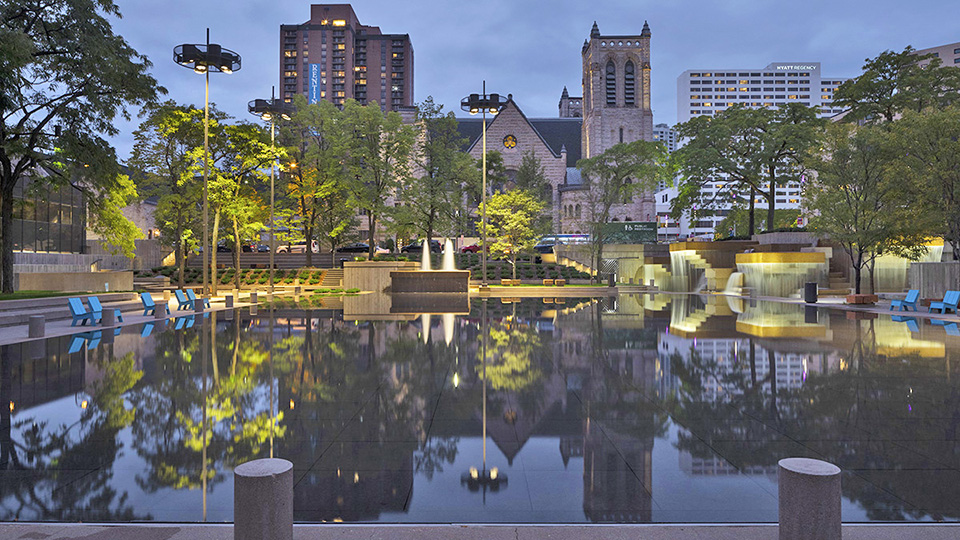 Peavey Plaza, Minneapolis, MN, 2019. Photo by Elizabeth Felicella, courtesy The Cultural Landscape Foundation.
Peavey Plaza, Minneapolis, MN, 2019. Photo by Elizabeth Felicella, courtesy The Cultural Landscape Foundation.
On October 17, 2019, TCLF announced that it would give the city a Stewardship Excellence Award, in recognition of the successful rehabilitation. In a ceremony five days later Mayor Jacob Frey accepted the award on behalf of the city.
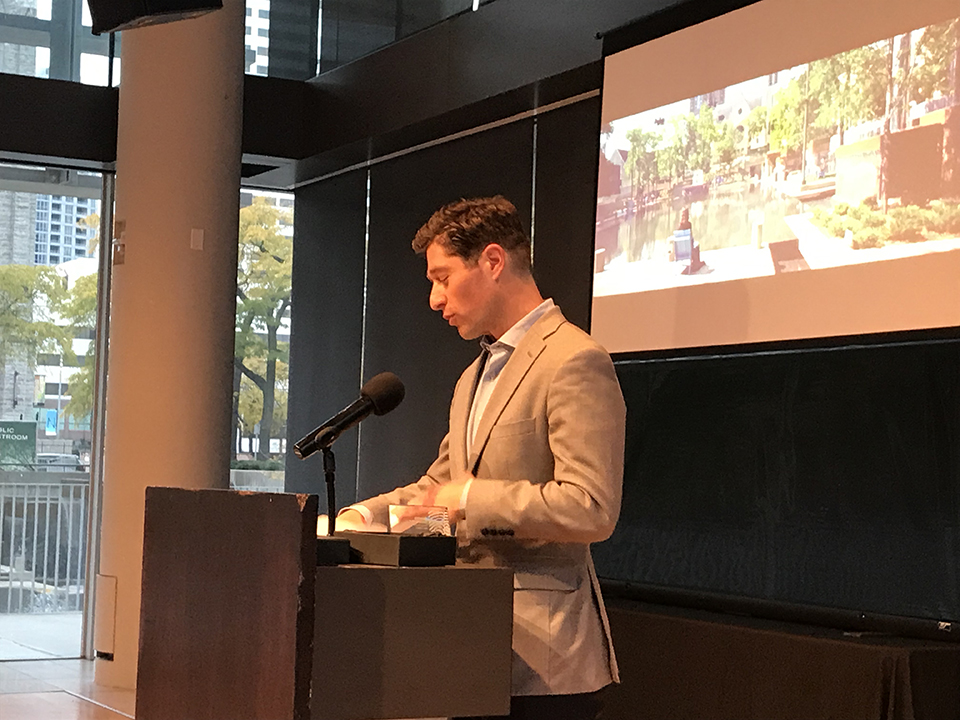 Mayor Jacob Frey accepts TCLF’s Stewardship Excellence Award, Minneapolis, MN, 2019. Photo by Charles. A Birnbaum, courtesy The Cultural Landscape Foundation.
Mayor Jacob Frey accepts TCLF’s Stewardship Excellence Award, Minneapolis, MN, 2019. Photo by Charles. A Birnbaum, courtesy The Cultural Landscape Foundation.
In 2023 the rehabilitation effort was a award a National ASLA Honor Award in the General Design category illustrating that authenticity can be valued when historic preservation and design and equally valued.
Selected Resources
“Killing Modernism with Fuzzy Math, Bad Information and False Choices,” April 11, 2012
"Peavey Commission Response,” April 17, 2012
“Peavey Plaza: Heritage Preservation Commission Delays Demolition,” April 19, 2012
“M. Paul Friedberg Creates New Concept for Peavey Plaza,” May 16, 2012
“Peavey Plaza Nomination Gets the Go-Ahead,” November 19, 2012
“Breaking News: Peavey Plaza Listed in National Register of Historic Places,” January 17, 2013
“At Peavey Plaza, Demolition Halted,” August 6, 2013
“Settlement Agreement Reached on Minneapolis’ Peavey Plaza,” October 7, 2013
“A Bright Outlook for Peavey Plaza?,” August 26, 2016
“Peavey Plaza Rehabilitation Inches Forward,” March 10, 2017
“Peavey Plaza Faces New Challenges,” July 17, 2017
“Controversial Rehab of Peavey Plaza Moves Ahead,” January 11, 2018
“Peavey Plaza Rehab Begins,” July 2, 2018
“Peavey Plaza Reopens at Last,” July 22, 2019
“City of Minneapolis Earns TCLF’s Stewardship Excellence Award,” September 30, 2019
“Stewardship Excellence Award: The City of Minneapolis”
“Mayor Frey Accepts Stewardship Award on Behalf of Minneapolis,” October 28, 2019
“Rehabilitating Postwar Plazas: A Primer,” December 5, 2019
“Peavey Plaza: A Year after the Ribbon-Cutting,” July 27, 2020
“M. Paul Friedberg and Charles Birnbaum Letter Re: Peavey Plaza Design Proposals”
“M. Paul Friedberg on Change and Continuity in Landscape Architecture”
Selected Media Coverage
“Preservationists Aim to Halt Peavey Plaza Redesign in Minneapolis,” Curtis Gilbert, Minneapolis Public Radio, May 17, 2012 Peavey Plaza Press Coverage April 2012 Peavey Plaza Press Coverage 2011 Peavey Plaza Press Coverage 2010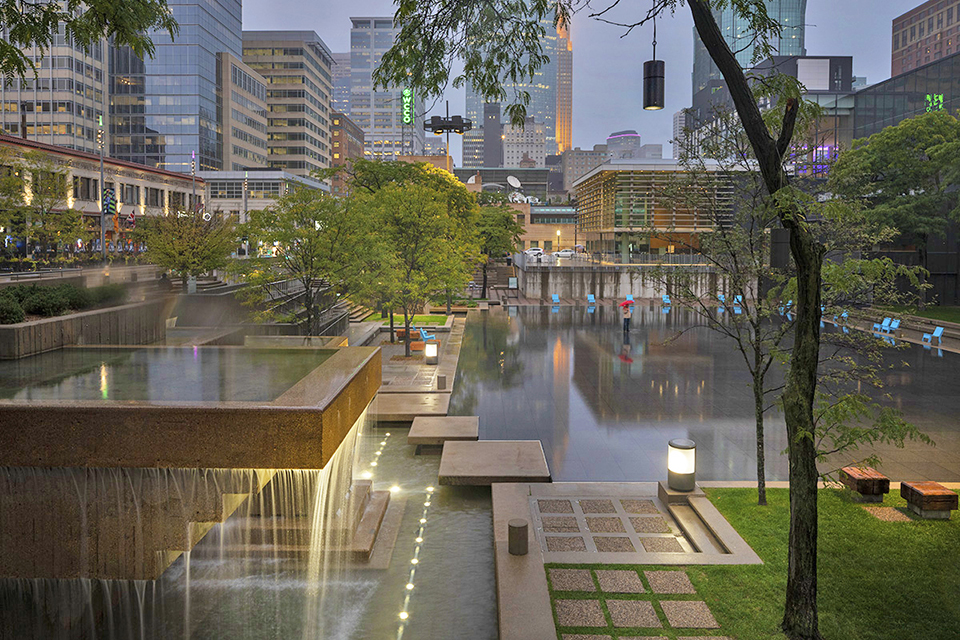
-
Peavey Plaza, Minneapolis, MN, 2019. Photo by Elizabeth Felicella.
